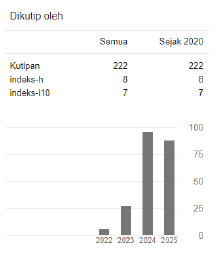Teaching of Language Skills to Students with Autism Spectrum Disorder during the COVID-19 Pandemic
 https://doi.org/10.54012/ijcer.v3i2.314
https://doi.org/10.54012/ijcer.v3i2.314
 Abstract views: 450
Abstract views: 450
 PDF downloads: 145
PDF downloads: 145
Keywords:
language skills, autism spectrum disorder, COVID-19 pandemic, special needs education, philippinesAbstract
This phenomenological study aimed to describe the teaching experiences, coping mechanisms, insights, and new teaching techniques of teachers in teaching language skills to students with Autism Spectrum Disorder (ASD) amidst pandemic. This study used a qualitative research design and the Colaizzi analysis strategy in analyzing the results. The five licensed Special Education teachers in both elementary and high school levels were selected through purposive sampling. The researchers constructed an interview guide and conducted semi-structured in-depth interviews. Findings and analyses of the study showed that the sudden shift of the programs and the intensified difficulty in getting the attention of the students with ASD were the challenges these teachers experienced. Consequently, the teachers motivated themselves to continue teaching, but sometimes the support from various support systems was inadequate. Further, they adapted a medical strategy and modified some traditional techniques to ensure the effectiveness of the instruction. The teachers can take advantage of the impairments with their teaching techniques.
Downloads
References
Jung, L.A. (2020). Accommodations, Modifications, and Intervention at a Distance. http://www.ascd.org/publications/educational-leadership/summer20/vol77/num10/Accommodations,-Modifications,-and-Intervention-at-a-Distance.aspx?fbclid=IwAR3J_9kEjIFGEvl5qOdRIYZrLeUaFN8nohM9p98ffaXSBt9F00cEWYv-T1Q
American Psychiatric Association. (2013). Diagnostic and statistical manual of mental disorders, 5th edn (DSM-5). Arlington, VA: American Psychiatric Publishing.
LaFrance, D.L. & Miguel, C.F. (2014). Teaching Verbal Behavior to Children with Autism Spectrum Disorders. doi: 10.1007/978-1-4939-0401-3_16
Low, H.M., Lee, L.W. (2011) Teaching of Speech, Language and Communication Skills for Young Children with Severe Autism Spectrum Disorders: What Do Educators Need to Know? https://files.eric.ed.gov/fulltext/EJ955538.pdf
Pelios, L. & Sucharzewski, A. (2004). Teaching Receptive Language to Children with Autism: A Selective Overview. doi: 10.1037/h0100123.
Ding, E., Mahajan, L., Molina, E., & Pushparatnam, A. (2021). Breaking old habits and adopting new ones: how to change teaching practice when change is hard. https://blogs.worldbank.org/education/breaking-old-habits-and-adopting-new-ones-how-change-teaching-practice-when-change-hard?fbclid=IwAR3lVOTI03ZD_kK1efV-mIGQawcs8Eqz_1wh4AlbBM0HU-NpT66DAoRHIu0
Valentine, D. (2002). Distance Learning: Promises, Problems, and Possibilities. https://www.westga.edu/~distance/ojdla/fall53/valentine53.html?fbclid=IwAR12AtQonU5VM21h9sdxx0XK2c4tANUzl93nC1vKaoofFQDN8gvIHeGafF0
Simone, J. (2020). How Can School Leaders Support Engaging Remote Education? https://edtechmagazine.com/k12/article/2020/09/how-can-school-leaders-support-engaging-remote-education.
Beenie, M. (2018). Executive function: what is it, and how do we support it in those with autism? Part I. https://autismawarenesscentre.com/executive-function-what-is-it-and-how-do-we-support-it-in-those-with-autism-part-i/
Dwyer, P. (2020). Students with Autism: Online Resources & Support. https://www.publicservicedegrees.org/resources/students-with-autism/?fbclid=IwAR0rm1fR2DL7mvRr-3KbNgrOdRPoar6KnsdaluQUagDyBs4jYqgnZ-GKL_Y
Martinali, J. (2017). The impact of sounds on autistic children’s behaviors. https://www.noldus.com/blog/impact-sounds-autistic-childrens-behaviors
Collie, R.J. & Martin, A. (2017). Teacher motivation profiles and how they impact wellbeing. https://www.teachermagazine.com/au_en/articles/teacher-motivation-profiles-and-how-they-impact-wellbeing?fbclid=IwAR2IFOI9XRt8adpt9A0YyIvV1wgybBh-bvW6DtGuEWHd5d92-Zv0iA038eI
Sinclair, C. (2008). Initial and changing student teacher motivation and commitment to teaching. Asia-Pacific Journal of Teacher Education, 36, 79–104.10.1080/13598660801971658
Kneschke, R. (2020). Teacher motivation is vital – and COVID-19 may be hurting it. https://theconversation.com/teacher-motivation-is-vital-and-covid-19-may-be-hurting-it-149345?fbclid=IwAR3hHhiipPyGfwvHc4F-PPQ2l3Ld6JJTqoueZLCoGYkkTsmdZGlPMW6vU-8
Rahmati, A., Sajjadi, M.S. & Negarestani, A. (2018). A Spiritual Approach to Job Satisfaction and Motivation among Special Education Teachers. http://jhsme.muq.ac.ir/files/site1/user_files_47cdd4/drrahmati-A-10-201-1-c1369b5.pdf?fbclid=IwAR3_7MSglbVLjOwBWH6q9pnv_na_fAUMnXFOk2gMfNnrCwTqkzvgo1tsq0k
Fernando, S.L. (2019). Fernando: Spiritual motivation. https://www.sunstar.com.ph/article/1807662/Baguio/Opinion/Paradigm?fbclid=IwAR2bcBHDsJLnfLgTXSTEiRN6Z50uom8uKxhVL9o-qWxCpjBdMrAJn6ZzCjg
Portis, C. (2019). The Importance of a Strong Support System. https://www.americanbar.org/groups/young_lawyers/projects/no-limits/the-importance-of-strong-support/
Logsdon, A. (2021). The Important Role of Parents in Special Education. https://www.verywellfamily.com/parental-importance-special-education-2162701
Branstetter, R. (2020). How Parents Can Support Children With Special Needs During Distance Learning. https://greatergood.berkeley.edu/article/item/how_parents_can_support_children_with_special_needs_during_distance_learning
Meyer, J. (2017). Music Education with Autistic Students in the Mainstream Elementary Classroom. https://tspace.library.utoronto.ca/bitstream/1807/77125/1/Meyer_Jacqueline_201706_MT_MTRP.pdf
Schnee, A. (2020). Clinical corner: What goes into teaching WH questions? Science in Autism Treatment, 17(5).
Hobbs, K.G. (2021). The Benefits of Visual Supports for Children with Autism. https://www.autismparentingmagazine.com/benefits-of-autism-visual-supports/
MacLeod-Bluver, C. (2020). Distance Learning: Supporting Students with Disabilities. https://blog.betterlesson.com/distance-learning-supporting-students-with-disabilities
Sarris, M. (2016). WHAT DO WE KNOW ABOUT NOISE SENSITIVITY IN AUTISM? https://iancommunity.org/ssc/noise-sensitivity-autism
Butler, L. D. (2016). Developing Your Support System. http://socialwork.buffalo.edu/resources/self-care-starter-kit/additional-self-care-resources/developing-your-support-system.html
Raglio, A., Traficante, D. & Oasi, O. (2011). ‘Autism and music therapy: intersubjective approach and music therapy assessment’. Nordic Journal of Music Therapy, 20(2), 123–41.
Buday, E. M. (1995). The effects of signed and spoken words taught with music on sign and speech imitation by children with autism. Journal of Music Therapy, 32, 189-202.
Simpson, K. & Keen, D. (2010). ‘Teaching young children with autism graphic symbols embedded within an interactive song’. Journal of Developmental and Physical Disabilities, 20, 165–77.
Brownell, M. D. (2002). ‘Musically adapted social stories to modify behaviours in students with autism: four case studies’. Journal of Music Therapy, 39, 117–44.
Health Talk Organization. (2020). Life on the Autism Spectrum. https://healthtalk.org/life-autism-spectrum/communication-interaction-autism
Reeve, C. (2017). 3 Things You Need to Know to Teach Students With ASD to Answer Questions. https://autismclassroomresources.com/answer-questions-asd/
Long, S. (2016). Answering Why & How Questions. https://theautismhelper.com/answering-why-how-questions/
Loring, W. & Hamilton, M. (2011). Visual Supports and Autism. https://www.autismspeaks.org/sites/default/files/2018-08/Visual%20Supports%20Tool%20Kit.pdf
Reeve, C. (2017). 3 Things You Need to Know to Teach Students With ASD to Answer Questions. https://autismclassroomresources.com/answer-questions-asd/
Stenger, M. (2014). 5 Research-Based Tips for Providing Students with Meaningful Feedback. https://www.edutopia.org/blog/tips-providing-students-meaningful-feedback-marianne-stenger
Downloads
Published
How to Cite
Issue
Section
License
Copyright (c) 2024 Cristy Grace A. Ngo Ngo, Nikka L. Duhaylungsod, Norhania B. Sacatan

This work is licensed under a Creative Commons Attribution-ShareAlike 4.0 International License.









